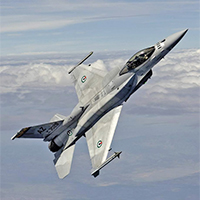South Korea upgrades To F-16E

South Korea is spending several hundred million dollars to upgrade most their 140 KF-16 fighters. These were assembled in South Korea from 1994 to 2004 under license and are going through a mid-life upgrade in the United States. This will involves installing a more powerful AESA radar, new electronics (displays, sensors and computers) as well as new cabling and other related components f0r 134 KF-16s. The upgrades will begin in 2014 and the first completed aircraft will be ready by 2019. Because not all the new features have been decided on yet the exact price is not yet known but will be at least $4 million per aircraft. The most time consuming aspect will be removing and replacing much of the cabling. The interior of an F-16 is a very crowded place and it’s a tedious effort getting in there to do major upgrades.
The AESA (Active Electronically Scanned Array) radars are becoming standard equipment in modern warplanes. AESA is more reliable and, increasingly, no more expensive than the older mechanical (a small dish that moves around inside a dome) radar. AESA is also easier and cheaper to maintain, which makes a more expensive AESA cheaper, over its lifetime, than a cheaper (to buy) mechanically scanned radar. AESA type radars have been around a long time, popular mainly for their ability deal with lots of targets simultaneously, and produce a more accurate picture of what is out there. AESA radar consists of thousands of tiny radars that can be independently aimed in different directions.
An AESA radar made the U.S. E-8 JSTARS aircraft possible, as it enabled it to locate vehicles moving on the ground. An innovative and much smaller MP-RTIP AESA radar for the RQ-4 Global Hawk UAV can also spot smaller objects on the ground. Alas this AESA radar is used at high altitude (over 10 kilometers/31,000 feet), too far for a high-energy (electronics destroying) signal. But other UAVs, like Reaper, are cheaper and fly lower, low enough to zap ground targets with the electronics-destroying beam. For heavily defended or very distant targets the cruise missile approach, while more expensive, would get the job done.
While AESA makes fighters much more effective, it’s the many other uses of AESA that make this technology so attractive to warplane designers. For example, the U.S. Air Force has been equipping some of its fighters with the ability to focus the high-powered microwave (HPM) effects found in AESA radar technology. AESA is able to focus a concentrated beam of radio energy that can damage electronic components of a distant target. The air force won’t, for obvious reasons, discuss the exact “kill range” of the various models of AESA radars on American warplanes (the F-35 and F-22 have the most powerful ones). However, it is known that “range” in this case is an elastic thing. Depending on how well the target electronics are hardened against EMP, more electrical power will be required to do damage. Moreover, the electrical power of the various AESA radars in service varies as well. The air force has said that the larger AESA radars it is developing would be able to zap cruise missile guidance systems up to 180 kilometers away.
The U.S. F-16 is one of the most modified jet fighters in service. While most are still called the F-16C, there are actually six major mods, identified by block number (32, 40, 42, 50, 52, 60), plus the Israeli F-16I, which is a major modification of the Block 52. The F-16D is a two seat trainer version of F-16Cs. The various block mods included a large variety of new components (five engines, four sets of avionics, five generations of electronic warfare gear, five radars and many other mechanical, software, cockpit and electrical mods.)